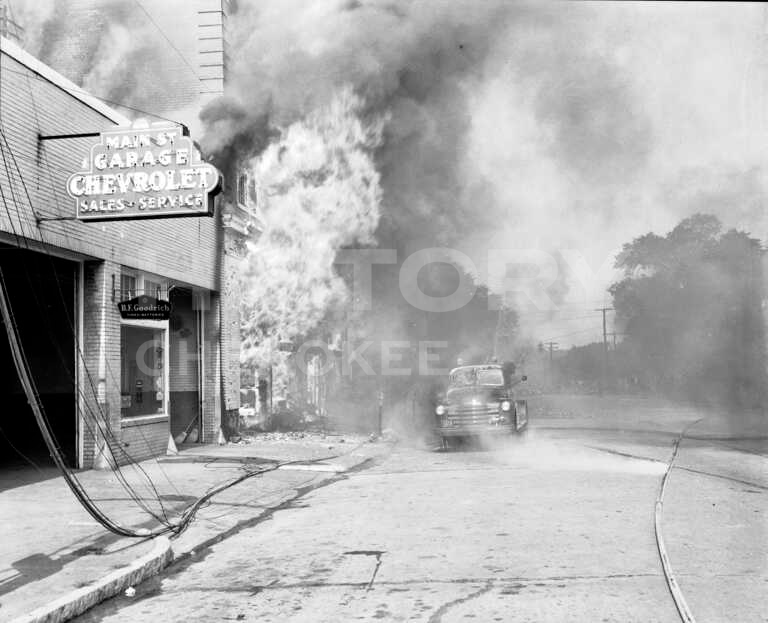Trials by Fire
Canton’s Recovery From the Flames of War and Industry
by Bruce Baker
If there are any avid gamers reading, they’ll almost certainly recognize this quote from Fallout character Joshua Graham: “I survived because the fire inside me burned brighter than the fires around me.” The same can be said of a city, as well. Most of us are familiar with the rebuilding of Chicago after the Great Chicago Fire in 1871, or know that the Phoenix is considered a symbol of Atlanta, referencing its rebirth after the Union Army burned much of it in 1864. These are large metropolitan areas, whose survival really was not surprising. However, when disasters strike smaller communities, their survival might be imperiled. Canton has endured two significant fires in its history, both worthy of mention.
The first is the most famous, the largest and the one that could have spelled the end. In July 1864, Atlanta had fallen to the Union Army. Many people in the North felt that capturing Atlanta would itself end the war. However, the reality was emerging that this was not the case. As such, Gen. William T. Sherman’s March to the Sea began. It ran from Nov. 15 through Dec. 21 of that year, and stands as the most destructive campaign against a civilian population in the Civil War. Its goal was to break the spirit of the South to continue fighting. And, as the war ended scarcely four months later, it can be argued that, while brutal, it accomplished its mission.
Once resolved upon this course, and shortly before leaving, the 5th Ohio Cavalry Regiment, under command of Maj. Thomas Heath, burned Canton to the ground, specifically targeting the home of Gov. Joseph Brown. It was done sometime during the first week of November. The versions I’ve read vary some, but more than half of the city was destroyed, and most reports estimate the destruction at closer to two-thirds of the town.
While Canton served as Cherokee’s county seat, the town’s population was only around 200 people at the time. So, its survival was not a sure thing. As an example, in neighboring Cass County (today Bartow County), the county seat of Cassville likewise was burned around the same time (Nov. 5, 1864), and it never was rebuilt. The county seat instead was relocated to Cartersville, where it remains to this day.
Photo: Joseph E. Brown

Less known, but equally serious, was a fire that broke out in downtown Canton on July 29, 1955. This time, it was not a deliberate act; it was the result of an industrial accident. The Cantex Manufacturing facility, a textile plant making corduroy fabric, was a significant employer at the time.
In textile operations, fine fibers separate from the cloth during processing, — generically are referred to as lint — and represent a constant fire hazard. It’s believed that a boiler explosion ignited a fire. With the ready supply of lint as fuel, it spread quickly, consuming not only the entire manufacturing plant, but also damaging or destroying nearby businesses, including a Chevrolet dealership, a grocery store, the Main Street garage and the offices of the local paper (The North Georgia Tribune). Firefighters from Canton and neighboring communities battled the blaze, extinguishing it eventually, but not before it caused significant damage and loss of life.
The obituary of Jonah Chadwick tells the story succinctly and poignantly: “Funeral services for Jonah A. Chadwick, 44, who died in the $1,500,000 Canton fire, were held Saturday at 2 p.m. at Mt. Pisgah Baptist Church in Cumming. Officiating were the Rev. Paul Thompson, the Rev. Jay Bottoms and the Rev. Jay Sewell. Burial was in the churchyard. Mr. Chadwick’s body was recovered Friday. He was a jig operator at the Cantex Co., a corduroy manufacturing plant, which was one of five businesses that burned.”
Photo: Cantex Fire, 6/29/1955 from the Buddy Alexander Collection

I don’t know where the dollar figure referenced came from, but $1.5 million in 1955, adjusted for inflation, represents the equivalent of just over $16.5 million today. Except for a reference in November 1958 of the settling of a legal dispute between Cantex and the insurance company over what was and was not included in the policy’s coverage, I can find no other mention of Cantex, and I believe it closed its doors forever.
That was not so for the city of Canton; it has carried on from the flames of war and those of industrial calamity — perhaps, in part, because the spirit of its residents always has burned brighter than any fire that thus far has attempted to consume it.
History Cherokee's Cherokee County History Center is a museum with the mission of preserving and sharing Cherokee County’s rich past from pre-history to modern day. Stay in touch with the latest happenings by subscribing to emails and newsletters at the bottom of this page.
